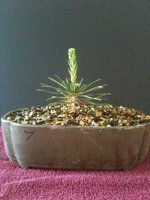Leo in N E Illinois
The Professor
- Messages
- 11,494
- Reaction score
- 23,863
- USDA Zone
- 5b
@KillerButts
Anthocyanin metabolism, has nothing to do with movement of iron in or through a plant cell. Separate processes.
As to your question, is the anthocyanin transported to the "red or purple areas" or is it revealed by the withdrawing of the chlorophyll, -the answer is, I don't know. Generally I assume it is revealed by the withdrawing of the chlorophyll. But I do not have a citation for that.
Iron, as a iron porphyrin compound (a heme) is important in one of the steps of sugar manufacture, but my molecular biology days are 40 years ago. "I ferget". Iron is a necessary nutrient because of its use in metabolism.
Chlorophyll is a porphyrin, with magnesium in the center of the porphyrin ring. Chlorosis most often is a deficiency of magnesium. However, because iron is crucial in the intermediate steps of the manufacture of sugars, chlorosis can also be caused by a lack of iron. Similar symptoms, different shortages. Usually if I see chlorosis I supplement both iron and magnesium.
Anthocyanin metabolism, has nothing to do with movement of iron in or through a plant cell. Separate processes.
As to your question, is the anthocyanin transported to the "red or purple areas" or is it revealed by the withdrawing of the chlorophyll, -the answer is, I don't know. Generally I assume it is revealed by the withdrawing of the chlorophyll. But I do not have a citation for that.
Iron, as a iron porphyrin compound (a heme) is important in one of the steps of sugar manufacture, but my molecular biology days are 40 years ago. "I ferget". Iron is a necessary nutrient because of its use in metabolism.
Chlorophyll is a porphyrin, with magnesium in the center of the porphyrin ring. Chlorosis most often is a deficiency of magnesium. However, because iron is crucial in the intermediate steps of the manufacture of sugars, chlorosis can also be caused by a lack of iron. Similar symptoms, different shortages. Usually if I see chlorosis I supplement both iron and magnesium.




